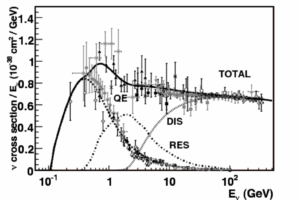Energy of Neutrinos

This graph illustrates how the probability of neutrino interactions (cross-section) varies with their energy. Notably:
-
Low Energy (<1 GeV): Cross-sections are minimal, indicating neutrinos rarely interact.
-
Intermediate Energy (1–10 GeV): There’s a significant increase in interaction probability.
-
High Energy (>10 GeV): The cross-section continues to rise, though the rate of increase may vary depending on the interaction type.
 Average Energy of Neutrinos by Source
Average Energy of Neutrinos by Source
- Solar neutrinos: ~0.1 to 10 MeV (average ~0.5 MeV)
- Atmospheric neutrinos: ~100 MeV to several GeV (average ~1 GeV)
- Supernova neutrinos: ~10 to 50 MeV
- Reactor neutrinos: ~2 MeV
- Cosmic neutrino background: ~10⁻⁴ eV
 What Happens if a Neutrino Interacts with a Human?
What Happens if a Neutrino Interacts with a Human?
- ~100 trillion solar neutrinos pass through your body every second.
- Almost none interact — they pass through atoms unimpeded.
- If interaction occurs (via weak force), it might:
- Scatter off a nucleon or electron
- Produce a lepton (electron or muon)
- Cause nuclear recoil or Cherenkov radiation
- These effects are harmless and extremely rare.
 Neutrino Interaction Cross-Section vs. Energy
Neutrino Interaction Cross-Section vs. Energy
Source: Wikimedia Commons – Log-log plot of neutrino interaction cross-section vs. energy